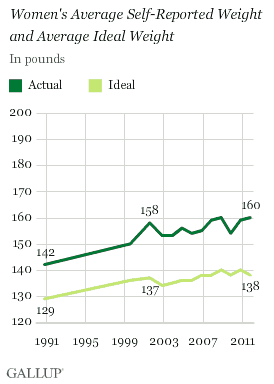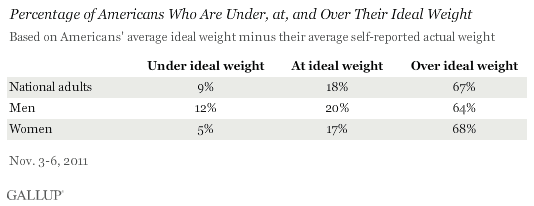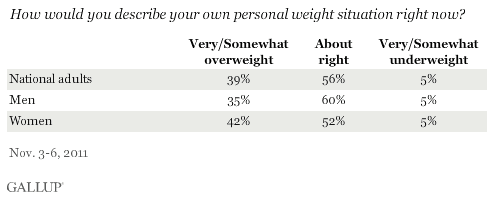WASHINGTON, D.C. -- American men, on average, say they weigh 196 pounds and women say they weigh 160 pounds. Both figures are nearly 20 pounds higher than the average that men and women reported in 1990. As Americans' actual weight has increased, so has their ideal weight.


Today, men on average say their ideal weight is 181 pounds and women say 138 pounds.
Men's and women's perceptions of their own ideal weight have generally increased over the same period that their self-reported actual weight has increased, although to a somewhat smaller degree. This means that not only do men and women report that they weigh more today versus 20 years ago, but they are also getting further away from their ideal weight.
Comparing the self-reports of actual and ideal weights, the average man weighs 15 pounds more than his ideal today, compared with 9 pounds in 1990. The average woman weighs 22 pounds more than her ideal today, compared with 13 pounds in 1990. The current figures for men and women are the highest Gallup has measured to date.
These results are based on Gallup's annual Health and Healthcare survey, conducted Nov. 3-6. Gallup has asked Americans to say how much they weigh yearly since 2001 and in 1990 and 1999.
Subtracting men's and women's average self-reported weight from their average ideal weight reveals that 64% of men and 68% of women are currently over their ideal weight.

All told, 67% of Americans are over their ideal weight, up slightly from the 62% found in the same poll last year.
In separate daily polling, Gallup and Healthways track Americans' self-reported height and weight to compute body mass index (BMI) scores as part of the Gallup-Healthways Well-Being Index. These BMI calculations found that 61.6% of Americans were either overweight or obese based on government definitions (35.8% were overweight and 25.8% were obese) in the third quarter of this year.
Both figures, however, still far exceed the percentage of Americans who personally describe themselves as overweight -- 39% in the Nov. 3-6 Health and Healthcare survey. The majority of Americans say their weight is "about right," as they have in most of the past 20 years.

The disconnect between the percentage who are over their ideal weight and the percentage who say they are overweight may come from Americans' own reluctance to describe themselves using such a term. Additionally, Gallup's data find roughly one in four Americans are between 1 and 10 pounds over their ideal weight, many of whom may be more inclined to view their weight as "about right" than as "overweight."
Bottom Line
The U.S. Centers for Disease Control and Prevention finds obesity has increased significantly over the past 20 years. Gallup's data reveal that Americans' self-reports of their own weight have also increased over the same period. Americans' average ideal weight has increased as well, showing men and women are adapting their ideal to their now higher actual weights. At the same time, the percentage of Americans who describe themselves as overweight has remained essentially unchanged over the past 20 years. While Americans are getting heavier, many may not recognize it or acknowledge it.
Survey Methods
Results for this Gallup poll are based on telephone interviews conducted Nov. 3-6, 2011, with a random sample of 1,012 adults, aged 18 and older, living in all 50 U.S. states and the District of Columbia, selected using random-digit-dial sampling.
For results based on the total sample of national adults, one can say with 95% confidence that the maximum margin of sampling error is ±4 percentage points.
Gallup surveyed 532 men and 480 women. For results based on men, one can say with 95% confidence that the maximum margin of sampling error is ±5 percentage points. For results based on women, one can say with 95% confidence that the maximum margin of sampling error is ±6 percentage points.
Interviews are conducted with respondents on landline telephones and cellular phones, with interviews conducted in Spanish for respondents who are primarily Spanish-speaking. Each sample includes a minimum quota of 400 cell phone respondents and 600 landline respondents per 1,000 national adults, with additional minimum quotas among landline respondents by region. Landline telephone numbers are chosen at random among listed telephone numbers. Cell phone numbers are selected using random-digit-dial methods. Landline respondents are chosen at random within each household on the basis of which member had the most recent birthday.
Samples are weighted by gender, age, race, Hispanic ethnicity, education, region, adults in the household, and phone status (cell phone only/landline only/both, cell phone mostly, and having an unlisted landline number). Demographic weighting targets are based on the March 2010 Current Population Survey figures for the aged 18 and older non-institutionalized population living in U.S. telephone households. All reported margins of sampling error include the computed design effects for weighting and sample design.
In addition to sampling error, question wording and practical difficulties in conducting surveys can introduce error or bias into the findings of public opinion polls.
View methodology, full question results, and trend data.
For more details on Gallup's polling methodology, visit www.gallup.com.
